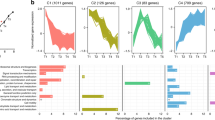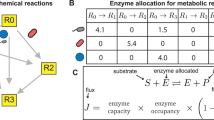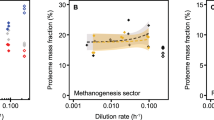Abstract
Growth substrates that maximize energy yield are widely thought to be utilized preferentially by microorganisms. However, observed distributions of microorganisms and their activities often deviate from predictions based solely on thermodynamic considerations of substrate energy supply. Here we present observations of the bioenergetics and growth yields of a metabolically flexible, thermophilic strain of the archaeon Acidianus when grown autotrophically on minimal medium with hydrogen (H2) or elemental sulfur (S°) as an electron donor, and S° or ferric iron (Fe3+) as an electron acceptor. Thermodynamic calculations indicate that S°/Fe3+ and H2/Fe3+ yield three- and fourfold more energy per mole of electrons transferred, respectively, than the H2/S° couple. However, biomass yields in Acidianus cultures provided with H2/S° were eightfold greater than when provided S°/Fe3+ or H2/Fe3+, indicating that the H2/S° redox couple is preferred. Indeed, cells provided with all three growth substrates (H2, Fe3+ and S°) grew preferentially by reduction of S° with H2. We conclude that substrate preference is dictated by differences in the energy demand of electron transfer reactions in Acidianus when grown with different substrates, rather than substrate energy supply.
This is a preview of subscription content, access via your institution
Access options
Access Nature and 54 other Nature Portfolio journals
Get Nature+, our best-value online-access subscription
$29.99 / 30 days
cancel any time
Subscribe to this journal
Receive 12 print issues and online access
$259.00 per year
only $21.58 per issue
Buy this article
- Purchase on Springer Link
- Instant access to full article PDF
Prices may be subject to local taxes which are calculated during checkout



Similar content being viewed by others
References
Falkowski, P. G., Fenchel, T. & Delong, E. F. The microbial engines that drive Earth’s biogeochemical cycles. Science 320, 1034–1039 (2008).
Lin, W., Wang, Y., Gorby, Y., Nealson, K. & Pan, Y. Integrating niche-based process and spatial process in biogeography of magnetotactic bacteria. Sci. Rep. 3, 1643 (2013).
Atlas, R. M. & Bartha, R. Microbial Ecology: Fundamentals and Applications (Benjamin-Cummings, 1986).
Amend, J. P., Rogers, K. L., Shock, E. L., Gurrieri, S. & Inguaggiato, S. Energetics of chemolithoautotrophy in the hydrothermal system of Vulcano Island, southern Italy. Geobiology 1, 37–58 (2003).
Shock, E. L. et al. Quantifying inorganic sources of geochemical energy in hydrothermal ecosystems, Yellowstone National Park, USA. Geochim. Cosmochim. Acta 74, 4005–4043 (2010).
Lovley, D. R. & Klug, M. J. Sulfate reducers can outcompete methanogens at freshwater sulfate concentrations. Appl. Environ. Microbiol. 45, 187–192 (1983).
Nealson, K. H. & Stahl, D. A. Microorganisms and biogeochemical cycles; what can we learn from layered microbial communities? Rev. Mineral. Geochem. 35, 5–34 (1997).
Spear, J. R., Walker, J. J., McCollom, T. M. & Pace, N. R. Hydrogen and bioenergetics in the Yellowstone geothermal ecosystem. Proc. Natl Acad. Sci. USA 102, 2555–2560 (2005).
Froelich, P. N. et al. Early oxidation of organic matter in pelagic sediments of the eastern equatorial Atlantic: suboxic diagenesis. Geochim. Cosmochim. Acta 43, 1075–1090 (1979).
Roden, E. E. & Wetzel, R. G. Competition between Fe(III)-reducing and methanogenic bacteria for acetate in iron-rich freshwater sediments. Microb. Ecol. 45, 252–258 (2003).
Boyd, E. S., Skidmore, M., Mitchell, A. C., Bakermans, C. & Peters, J. W. Methanogenesis in subglacial sediments. Environ. Microbiol. Rep. 2, 685–692 (2010).
Canfield, D. E. & Des Marais, D. J. Aerobic sulfate reduction in microbial mats. Science 251, 1471–1473 (1991).
D’ Hondt, S. et al. Distributions of microbial activities in deep subseafloor sediments. Science 306, 2216–2221 (2004).
Hansel, C. M. et al. Dominance of sulfur-fueled iron oxide reduction in low-sulfate freshwater sediments. ISME J. 9, 2400–2412 (2015).
Marounek, M., Fliegrova, K. & Bartos, S. Metabolism and some characteristics of ruminal strains of Megasphaera elsdenii. Appl. Environ. Microbiol. 55, 1570–1573 (1989).
Urbieta, M. S. et al. Draft genome sequence of the novel thermoacidophilic archaeon Acidianus copahuensis strain ALE1, isolated from the Copahue volcanic area in Neuquén, Argentina. Genome Announc. 2, e00259-00214 (2014).
Segerer, A., Neuner, A., Kristjansson, J. K. & Stetter, K. O. Acidianus infernus gen. nov., sp. nov., and Acidianus brierleyi Comb. nov.: Facultatively aerobic, extremely acidophilic thermophilic sulfur-metabolizing Archaebacteria. Int. J. Syst. Bacteriol. 36, 559–564 (1986).
Plumb, J. J., Haddad, C. M., Gibson, J. A. E. & Franzmann, P. D. Acidianus sulfidivorans sp. nov., an extremely acidophilic, thermophilic archaeon isolated from a solfatara on Lihir Island, Papua New Guinea, and emendation of the genus description. Int. J. Syst. Evol. Microbiol. 57, 1418–1423 (2007).
Thauer, R. K., Jungermann, K. & Decker, K. Energy conservation in chemotrophic anaerobic bacteria. Bacteriol. Rev. 41, 100–180 (1977).
Boyd, E. S. & Druschel, G. K. Involvement of intermediate sulfur species in biological reduction of elemental sulfur under acidic, hydrothermal conditions. Appl. Environ. Microbiol. 79, 2061–2068 (2013).
Kamyshny, A. Solubility of cyclooctasulfur in pure water and sea water at different temperatures. Geochim. Cosmochim. Acta 73, 6022–6028 (2009).
Xu, Y. & Schoonen, M. A. A. The stability of thiosulfate in the presence of pyrite in low-temperature aqueous solutions. Geochim. Cosmochim. Acta 59, 4605–4622 (1995).
Nordstrom, D. K., Ball, J. W. & McClesky, R. B. in Ground Water to Surface Water: Chemistry of Thermal Outflows in Yellowstone National Park (eds Inskeep, W. P. & McDermott, T. R.) 143–162 (US Geological Survey, 2005).
Rickard, D. & Luther, G. W. Chemistry of iron sulfides. Chem. Rev. 107, 514–562 (2007).
Laska, S., Lottspeich, F. & Kletzin, A. Membrane-bound hydrogenase and sulfur reductase of the hyperthermophilic and acidophilic archaeon Acidianus ambivalens. Microbiology. 149, 2357–2371 (2003).
Veith, A. et al. Substrate pathways and mechanisms of inhibition in the sulfur oxygenase reductase of Acidianus ambivalens. Front. Microbiol. 2, 37 (2011).
Gorby, Y. A. et al. Electrically conductive bacterial nanowires produced by Shewanella oneidensis strain MR-1 and other microorganisms. Proc. Natl Acad. Sci. USA 103, 11358–11363 (2006).
Reguera, G. et al. Extracellular electron transfer via microbial nanowires. Nature 435, 1098–1101 (2005).
Leang, C., Coppi, M. V. & Lovley, D. R. OmcB, a c-type polyheme cytochrome, involved in Fe(III) reduction in Geobacter sulfurreducens. J. Bacteriol. 185, 2096–2103 (2003).
Myers, C. R. & Myers, J. M. Cloning and sequence of cymA a gene encoding a tetraheme cytochrome c required for reduction of iron(III), fumarate, and nitrate by Shewanella putrefaciens MR-1. J. Bacteriol. 179, 1143–1152 (1997).
Kletzin, A. et al. Cytochromes c in Archaea: distribution, maturation, cell architecture, and the special case of Ignicoccus hospitalis. Front. Microbiol. 6 (2015).
Mardanov, A. V. et al. Complete genome sequence of strain 1860, a crenarchaeon of the genus Pyrobaculum able to grow with various electron acceptors. J. Bacteriol. 194, 727–728 (2012).
Pirbadian, S. et al. Shewanella oneidensis MR-1 nanowires are outer membrane and periplasmic extensions of the extracellular electron transport components. Proc. Natl Acad. Sci. USA 111, 12883–12888 (2014).
Feinberg, L. F., Srikanth, R., Vachet, R. W. & Holden, J. F. Constraints on anaerobic respiration in the hyperthermophilic archaea Pyrobaculum islandicum and Pyrobaculum aerophilum. Appl. Environ. Microbiol. 74, 396–402 (2008).
Lovley, D. R., Phillips, E. J. P., Lonergan, D. J. & Widman, P. K. Fe(III) and S0 reduction by Pelobacter carbinolicus. Appl. Environ. Microbiol. 61, 2132–2138 (1995).
Thony-Meyer, L. Haem-polypeptide interactions during cytochrome c maturation. Biochim. Biophys. Acta-Bioenerg. 1459, 316–324 (2000).
Stevens, J. M., Daltrop, O., Allen, J. W. A. & Ferguson, S. J. C-type cytochrome formation: chemical and biological enigmas. Acc. Chem. Res. 37, 999–1007 (2004).
Malvankar, N. S., Yalcin, S. E., Tuominen, M. T. & Lovley, D. R. Visualization of charge propagation along individual pili proteins using ambient electrostatic force microscopy. Nat. Nanotech. 9, 1012–1017 (2014).
Malvankar, N. S. et al. Structural basis for metallic-like conductivity in microbial nanowires. mBio 6, e00084-00015 (2015).
Lassak, K., Ghosh, A. & Albers, S. V. Diversity, assembly and regulation of archaeal type IV pili-like and non-type-IV pili-like surface structures. Res. Microbiol. 163, 630–644 (2012).
Makarova, K. S., Koonin, E. V. & Albers, S. V. Diversity and evolution of type IV pili systems in Archaea. Front. Microbiol. 7, 667 (2016).
Szabo, Z. et al. Identification of diverse archaeal proteins with class III signal peptides cleaved by distinct archaeal prepilin peptidases. J. Bacteriol. 189, 772–778 (2007).
Esquivel, R. N., Xu, R. & Pohlschroder, M. Novel archaeal adhesion pilins with a conserved N terminus. J. Bacteriol. 195, 3808–3818 (2013).
Tan, Y. et al. Expressing the Geobacter metallireducens PilA in Geobacter sulfurreducens yields pili with exceptional conductivity. mBio 8, e02203-02216 (2017).
Langner, H. W., Jackson, C. R., Mcdermott, T. R. & Inskeep, W. P. Rapid oxidation of arsenite in a hot spring ecosystem, Yellowstone National Park. Environ. Sci. Technol. 35, 3302–3309 (2001).
Colman, D. R. et al. Ecological differentiation in planktonic and sediment-associated chemotrophic microbial populations in Yellowstone hot springs. FEMS Microbiol. Ecol. 92, fiw137 (2016).
Boyd, E. S. et al. Isolation, characterization, and ecology of sulfur-respiring Crenarchaea inhabiting acid-sulfate-chloride-containing geothermal springs in Yellowstone National Park. Appl. Environ. Microbiol. 73, 6669–6677 (2007).
Boyd, E. S., Cummings, D. E. & Geesey, G. G. Mineralogy influences structure and diversity of bacterial communities associated with geological substrata in a pristine aquifer. Microb. Ecol. 54, 170–182 (2007).
Hamilton, T. L., Peters, J. W., Skidmore, M. L. & Boyd, E. S. Molecular evidence for an active endogenous microbiome beneath glacial ice. ISME J. 7, 1402–1412 (2013).
Urschel, M. R., Hamilton, T. L., Roden, E. E. & Boyd, E. S. Substrate preference, uptake kinetics and bioenergetics in a facultatively autotrophic, thermoacidophilic crenarchaeote. FEMS Microbiol. Ecol. 92, fiw069 (2016).
Fogo, J. K. & Popowsky, M. Spectrophotometric determination of hydrogen sulfide - methylene blue method. Anal. Chem. 21, 732–734 (1949).
Viollier, E., Inglett, P. W., Hunter, K., Roychoudhury, A. N. & Van Cappellen, P. The ferrozine method revisited: Fe(II)/Fe(III) determination in natural waters. Appl. Geochem. 15, 785–790 (2000).
Cypionka, H. & Pfennig, N. Growth yields of Desulfotomaculum orientis with hydrogen in chemostat culture. Arch. Microbiol. 143, 396–399 (1986).
Amend, J. P. & Shock, E. L. Energetics of overall metabolic reactions of thermophilic and hyperthermophilic Archaea and bacteria. FEMS Microbiol. Rev. 25, 175–243 (2001).
Helgeson, H. C. Prediction of the thermodynamic properties of electrolytes at high pressures and temperatures. Phys. Chem. Earth. 13, 133–177 (1981).
McGlynn, S. E., Chadwick, G. L., Kempes, C. P. & Orphan, V. J. Single cell activity reveals direct electron transfer in methanotrophic consortia. Nature 526, 531–535 (2015).
Acknowledgements
This work was supported by National Science Foundation grant EAR-1123689 to E.S.B. and EAR-1123649 to E.L.S. and NASA Exobiology and Evolutionary Biology Grant (NNX13AI11G) to E.S.B. The NASA Astrobiology Institute is supported by grant NNA13AA94A to E.E.R. and E.S.B. and grant NNA15BB02A to E.L.S. and E.S.B. M.J.A. acknowledges support from the CONICYT Becas-Chile Scholarship program.
Author information
Authors and Affiliations
Contributions
M.J.A. and E.S.B. designed and conducted the experiment. E.E.R. assisted with genomic sequencing. E.L.S. and E.E.R. assisted with bioenergetic calculations. All authors contributed to the writing of this paper.
Corresponding author
Ethics declarations
Competing interests
The authors declare no competing financial interests.
Supplementary information
Supplementary Information
Supplementary Information (PDF 873 kb)
Rights and permissions
About this article
Cite this article
Amenabar, M., Shock, E., Roden, E. et al. Microbial substrate preference dictated by energy demand rather than supply. Nature Geosci 10, 577–581 (2017). https://doi.org/10.1038/ngeo2978
Received:
Accepted:
Published:
Issue Date:
DOI: https://doi.org/10.1038/ngeo2978
This article is cited by
-
Biochemical and microbiological characterization of a thermotolerant bacterial consortium involved in the corrosion of Aluminum Alloy 7075
World Journal of Microbiology and Biotechnology (2024)
-
Well-hidden methanogenesis in deep, organic-rich sediments of Guaymas Basin
The ISME Journal (2023)
-
Preferential substrate use decreases priming effects in contrasting treeline soils
Biogeochemistry (2023)
-
Phylogenomic analysis of novel Diaforarchaea is consistent with sulfite but not sulfate reduction in volcanic environments on early Earth
The ISME Journal (2020)
-
Evidence for fungi and gold redox interaction under Earth surface conditions
Nature Communications (2019)



